The best stationary blenders Philips: technical characteristics of devices and top 7 best models in the low- and middle-price segment
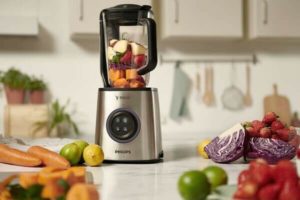 It is impossible to imagine a modern kitchen without kitchen appliances: microwave, mixer or blender.
It is impossible to imagine a modern kitchen without kitchen appliances: microwave, mixer or blender.
The blender is a versatile thing that allows you to mix, chop, and with special attachments - to whip and knead dough, replacing the mixer.
The benefit of the blender is undeniable, and the market offers a variety of models that differ not only in external design, but also in many characteristics.
Contents
How to choose a blender
Before you buy a blender, it's important to determine what functions it will perform. If it is needed for tasty smoothies and fruit purees, it is enough to do with inexpensive and not very powerful models. For a large family and culinary variety, a small, cheap blender would be a waste of money, because here you need a more powerful and capacious model..
Philips provides a large number of home stationary blenders to choose from to meet any needs.
The main thing is to find among them the one that is ideal for all the characteristics. And for this, you need to know what characteristics are important for a good blender.
Power
Depending on the power of the blender, the list of products that it can grind expands. For example, the most powerful blender will easily break ice chunks into fine crumbs, while the least powerful one, trying to do this, will simply burn out or break the blades.
The average power of stationary blenders ranges from 180 and up to 2300 watts.
They are divided into 4 categories according to the functions they perform:
- Up to 300 watts - Designed for soft ingredients, liquids. Good for mixing drinks.
- 300 - 700 watts - standard power for work in the kitchen. This blender is suitable for blending, chopping and crumbling. Capable of handling both cooked and raw food.
- 700 - 1500 watts - A complete blender capable of all functions, including ice maker. Features large size and roomy bowl.
- Above 1500 watts - A professional blender, used in food production. Capable of blending large quantities of ingredients over long periods of time.
Bowl size
The volume of the blender bowl directly depends on its power. For example, low-power blenders are balanced by a small volume bowl, while more advanced machines require a much larger working volume.
It is important to remember that the useful (aka working) volume is different from the nominal. Many products tend to increase in volume during cooking, and a bowl filled to the brim will not be able to accommodate the finished product.
The necessary size of the bowl is calculated depending on the size of the family:
- From 0.4 l - the volume designed for 1-2 servings. Suitable for the preparation of children's or sports meals, for the preparation of individual ingredients for dishes;
- 1 to 2 liters - the optimal size for a family of several people;
- From 2 liters - the choice for a large family, hosting guests or home cooking.
Speeds
The number of speeds directly depends on the power and affects the quality of chopping or mixing of products. At low speeds chunks remain quite large, while high speeds grind the product into mush or mix into a homogeneous mass. Each of the speeds has a different effect on a particular product, so the larger and more diverse the home menu, the greater the number of blender speeds may be needed.
Also, many blenders have turbo and pulse modes. Turbo mode turns the blender on at the highest speed. Pulse mode is good for chopping particularly hard products. In the process of rotation at maximum speed the knife makes pauses, allowing you to assess the degree of chopping, and the product to settle back to the bottom of the bowl.
To use the blender as an assistant in the kitchen, 4-5 speeds are enough. Lovers of improvisation and unusual dishes should pay attention to models with 10 or more speeds. Home production (mostly pastry shops) need the maximum number of blender speeds.
Attachments
Blender blade can be as a whole, or two separate parts, fixed crosswise.
There are three types of blender blades:
- straight blades;
- curved;
- with additional cutting surfaces.
Straight knives are the simplest and cheapest. The quality of chopping with such a knife is average - it has the so-called "dead zones", because of which the chopping is uneven.
Curved knives are installed in all mid-priced blenders. "Dead zones" of such knives do not have, and the quality of chopping will be high, and the product itself will be cooked evenly. Additional cutting edges make such blades versatile, positively affecting the performance and almost without increasing the final cost of the blender.
Material
The body of the blender can be either plastic or metal. It does not affect anything but the price and external parameters.
But the material of the bowl has its own set of pros and cons:
- Plastic. Very lightweight, does not emit harmful substances, does not break and does not crack when accidentally dropped (from a small height). Minus - is stained by the color of the product and washed not all the way.
- Metal. Robust, tolerates all temperatures (very cold or very hot food). Disadvantages - expensive, and the chopping process is not visible, and you have to be guided solely by time.
- Glass. Does not scratch, does not interact with the ingredients, through it is excellent to see the process of work. Disadvantages - very fragile and relatively heavy.
- Composite materials. Such a bowl is lightweight, transparent, does not stain or break. Disadvantages - expensive, and it is difficult to find a replacement for a broken one.
The clutch that connects the knives and the blender's torque mechanism should be made of steel or other durable material. Plastic couplings are much cheaper, but their service life is also several times less. Plastic tends to melt or crack under high loads..
overheat protection system
Only professional blenders that need to run at high speeds for long periods of time without stopping have overheat protection. A thermal fuse is installed in the supply circuit, the threshold of which is individual (120 degrees on average).
Type of power supply
Most stationary blenders operate on mains power. The length of the cord does not exceed 1.5 meters on average. The cord is not removable, the body at the attachment point is tightly closed and protected from moisture or dirt. This power option is proven and reliable.
If you're traveling or vacationing, the cordless blenders are the right choice. They are convenient because they do not depend on the length of the cord or the availability of outlets in the room. The disadvantage of a cordless blender is its operating time - only 20-30 minutes. This is enough for cooking one or two dishes, but you can not count on long-term use at one time.
Top 3 inexpensive Philips blenders (under 3000 p.)
This list consists of quality and comfortable devices, whose price is not more than 3 thousand rubles.
HR1625 Daily Collection
This is an immersion blender with the ability to use it as a stationary 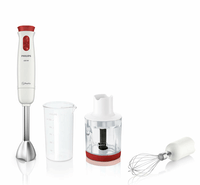
Main characteristics:
- Power output: 650 W.
- Number of speeds: 2.
- The presence of measuring cup and a chopper.
- Power from the network, the length of the cord 1.2 m.
- The average price in stores: 2,559 rubles.
Pros of
- low price
- A beautiful appearance;
- Does a good job with the basic functions: whip, mix, chop.
Disadvantages
- small volume of the chopper bowl;
- inconveniently located buttons.
HR2102 Daily Collection
Small-powered stationary blender, suitable for making fruit puree, 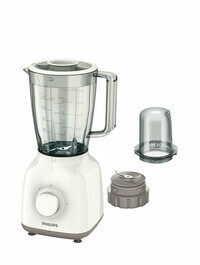
Main characteristics:
- Power output: 400 W.
- Number of speeds: 2.
- Impulse Mode.
- Chopper of 0.12 Lt.
- Plastic bowl.
- AC-powered, cord length 0.85 m.
- The average price in stores: 2 287 rubles.
Pros of
- low price;
- Good quality build;
- There is protection from being switched on if the glass is in the wrong position;
- A removable knife, which is easy to clean.
Cons
- low power;
- noisy;
- lack of instructions in the complete set.
HR2874 Daily Collection
Low-power blender that stood out with optional accessories. Thanks to the rich 
- Power: 350 W.
- Number of speeds: 1.
- In the complete set the nozzle-filter, travel bottle of volume 0,6 l, a mill of volume 0,35 l.
- The material of the bowl: plastic.
- Powered by the network, the cord is removable.
- Average price in stores: 2 191 rubles.
Advantages of
- compact size;
- rich packaging;
- easy to clean;
- low price.
Cons
- brittle plastic;
- overheats when working with thick ingredients;
- inconvenient attachment of nozzles.
Top 4 Philips blenders in the medium price segment
Mid-priced blenders combine three important features - power, functionality and quality. They are able to work equally well with a large number of ingredients.
HR3556 Viva Collection
Medium power blender with sturdy metal body and good delivery set. The 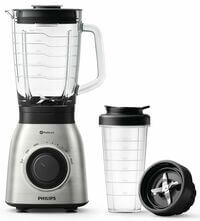
- Power: 700 watts.
- Stepless adjustable speed.
- Auxiliary pulse and ice maker.
- Metal body and glass bowl.
- Includes travel bottle of 0.6 liters.
- Mains power, removable cord.
- Average price in stores: 7 074 rubles.
Pros of
- beautiful appearance;
- Sucker-legs for attaching to the table;
- A large bowl volume (1.5 liters);
- power lock function.
Cons
- blades can not cope with large chunks;
- does not grind frozen food well;
- short cord;
- quickly clogs the area of the bowl under the knives.
HR3655 Avance Collection
Powerful metal blender designed for heavy duty, high volume 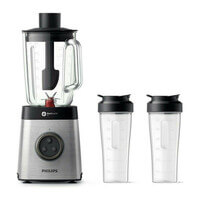
- Power: 1 400 W.
- Number of speeds: 4; smooth switching.
- Auxiliary pulse mode and ice pick.
- Metal body and glass bowl.
- Includes two travel bottles.
- Powered by the network, removable cord.
- Average price in stores: 8 590 rubles.
Advantages of
- high power;
- easy to disassemble and wash;
- smooth acceleration;
- the presence of two bottles;
- Includes a recipe book.
Disadvantages
- not airtight attachment of the blade (water or juice can leak);
- noisy at maximum speed;
- a lot of "dead zones" - poorly grinds small nuts;
- Extra high bowl.
HR2166 Viva Collection
Medium power blender with high speed.. Has a rich 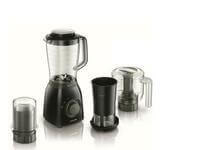
- Power: 600 watts.
- Number of speeds: 7; smooth switching.
- Optional pulse mode and ice pick.
- In the complete set the chopper, mill, nozzle-filter, additional knife.
- Material of the body and the bowl - plastic.
- AC power, cord length 1.3 m.
- The average price in stores: 4 987 rubles.
Pros of
- multifunctional;
- pleasant design;
- easy to clean in the dishwasher;
- rich set;
- quality-price ratio.
Disadvantages
- short power cord;
- very noisy;
- with a large load can "jump" on the surface;
- large size.
HR3752
Powerful stationary blender with minimal equipment. Its important feature 
- Power: 1 400 W.
- Smooth speed change, up to 35 000 rpm.
- Auxiliary pulse and ice-breaking modes.
- Metal body and plastic bowl.
- Powered by the network, the cord length of 1 m.
- Average price in stores: 18,990 rubles.
Pros of
- high power;
- The quality of construction and materials;
- the ability to turn on and off vacuum mode;
- large volume of the bowl;
- possibility of washing in the dishwasher;
- Velcro on the legs.
Disadvantages
- large dimensions - high non-detachable part on the motor unit;
- heavy;
- high price.
Useful video
From the video you will learn how to choose the best blender Philips:




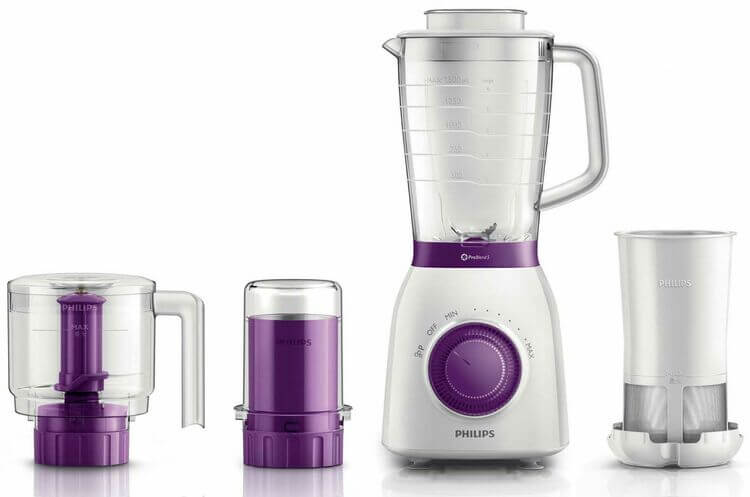
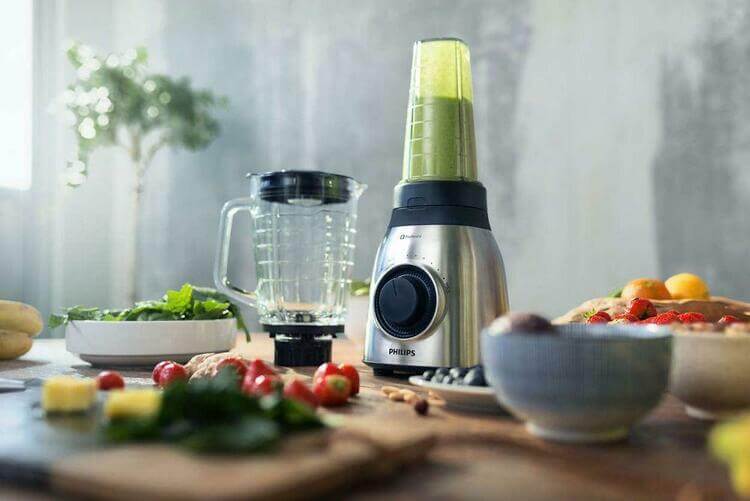
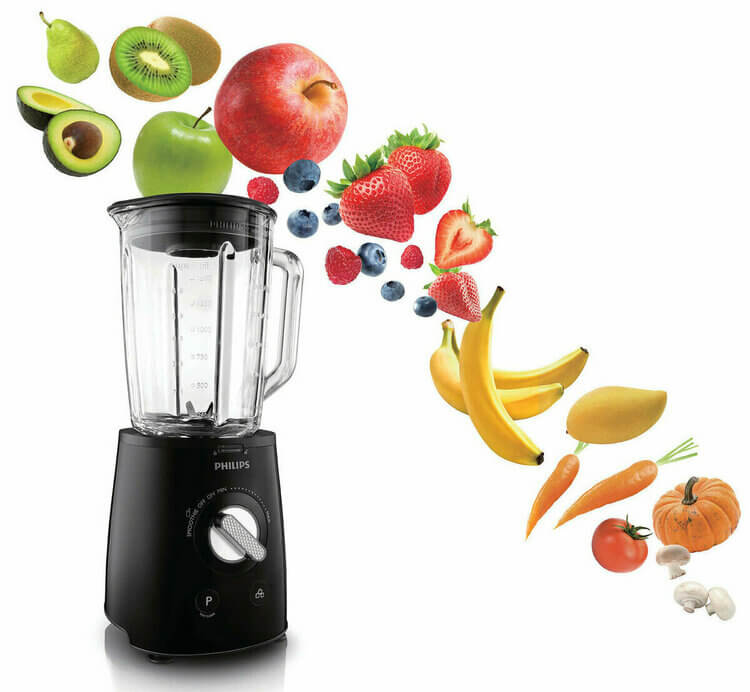
I recognize our HR2166 Viva Collection from the photo - it was given to us for my last birthday. Of course, you can't look a gift horse in the mouth, but we still want to change it - it's really noisy and bulky. Of course, juicer mode is nice (we often use it), but for us the noise exceeds all the pluses. It's better to choose something less functional, but making less noise.
I bought the HR2874 Daily Collection mainly for making smoothies. It copes with smoothies by leaps and bounds, with a large volume of cream soup it becomes uncomfortable. For this price it is an excellent model if you use it occasionally, but if you need a blender for regular cooking of large volume portions, it is better to choose another model. To the disadvantages of the model can include a fragile plastic, but the quality of cooking is still on high, just do not need to drop the blender on the tiles, as it once happened to me.